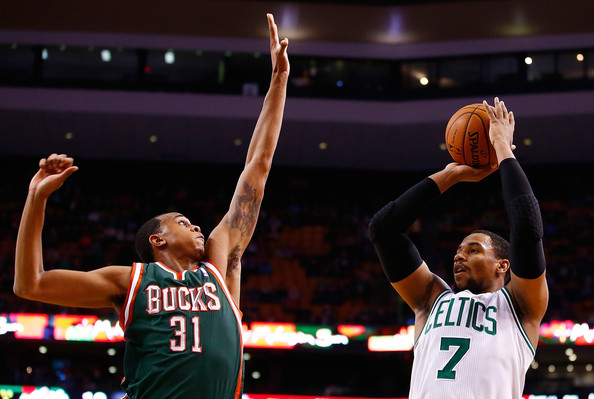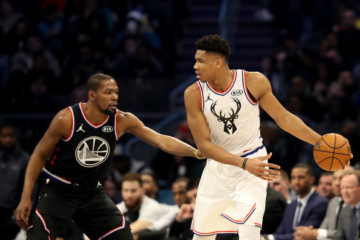2015-16 Fantasy Basketball: Intro to Points Leagues

Believe it or not, the NBA season is just five weeks away! I know, very, very sneaky of them. Opening Night is October 27, which gives fantasy basketball owners just a short time to join leagues, draft and be ready for the 2015-16 season.
If you’ve played fantasy hoops before, you probably prefer traditional rotisserie leagues (if so, Zack Rewis has you covered with his roto draft strategy piece), or even head-to-head category leagues, which you can read about in one of my columns from last week. However, there aren’t just two options out there any more. Points leagues are becoming very popular among fantasy owners, and they are definitely something you should consider if you’re looking to mix things up a little.
What are points leagues?
Points leagues follow the same basic scoring scenario as fantasy football leagues. You are matched up against a new opponent each week and the winner is determined by whoever tallies the most total points.
The categories you’re used to from roto or H2H category leagues are also used here, but instead of a running total, each category has a different point value assigned to it (just like in football where you get four points for a passing touchdown, one point for an extra point, etc.).
Here are the default scoring settings for ESPN’s points leagues:
- Points = 1 point
- Blocks = 1 point
- Steals = 1 point
- Assists = 1 point
- Rebounds = 1 point
- Field goals made = 1 point
- Field goals attempted = -1 point
- Free throws made = 1 point
- Free throws attempted = -1 point
- Turnovers = -1 point
Scoring on ESPN is completely customizable. My preference is to actually give certain categories more weight, rather than keep them at the one-point factory setting.
For instance, blocks aren’t as easy to come by as points, so I like to make blocks worth more than points (maybe 1.5 or even 2 points per block). This way, players like John Henson, who averaged just seven points per game last year, but chipped in two blocks, will be worth owning. We know that in roto and H2H category leagues, players with big block potential have tremendous value, so why should that be minimized in points leagues?
Why play points leagues?
I’ll be perfectly honest with you, I’m not a big fan of points leagues, but I can see why many are.
With points leagues, you really have an unlimited capacity when it comes to assigning points to different categories and it also allows you to add categories that you wouldn’t normally have in other formats.
For example, I love acknowledging a player who posts a massive triple-double. I’ve seen roto and H2H category leagues with triple-doubles as a category, and this is a big mistake. There were 46 triple-doubles in the NBA last year, yet they were produced by just 20 different players. In fact, 24 percent of them came from Russell Westbrook, who had 11. What this means, and it’s just reiterating what we’ve always known: triple-doubles are a rare commodity.
I don’t like instituting categories with such low occurrence rates, because just ONE can decide an entire roto season or help you win a H2H matchup with ease. This is very similar to fantasy baseball leagues that have complete games or hitting for the cycle as categories. You don’t need to be cute with the category settings simply because you want more of them. Quality is better than quantity.
These are categories you want to avoid in other formats, but in points leagues, they are perfectly fine. In the points league I play in, triple-doubles are worth five points, while double-doubles are worth two. It rewards you for having a player achieve these milestones, but doesn’t prevent your opponent from keeping pace either.
The other main reason people like points leagues is because they help regulate game volume.
If you read my primer on head-to-head category leagues, you know how important player game volume is to that format. But because being attentive and following the NBA’s schedule can give you such an edge in that format, it can also be a drawback for owners who don’t have as much time (or knowledge) to spend on it.
This is where points leagues come in.
Points leagues are very well-suited for more casual owners because of this one major detail. But how are you prevented from employing the same method as you would in H2H category leagues? Points leagues usually have a games played limit for each matchup. Each league is fully customizable, but in the league I play in, we can’t exceed 40 games played for the current matchup. That means that you can’t just stream guys all week — you need to sit some players who may lack minutes or are in a slump.
Other sites offer an alternative to the points league “equal play” rules. The leagues on Yahoo! and CBS are weekly lineups, where you set your lineup on Monday and don’t touch it again to the following week. Instead of the point totals accumulating, which would give teams with more games an advantage, they average your players’ totals for each week. So, if LeBron James had three games, and totaled 35, 17 and 49 points, he would get you a weekly score of 33.7 points.
Recommendation
As I’ve mentioned already, points leagues are not my jam, but I do see why they can be very popular, as well as beneficial to some owners. They offer the same great competition, but with less maintenance. And they also allow leagues to tweak the scoring settings in a way other formats can’t.
Even though I don’t really dig them, I still play in one, and that’s because I like to have some diversity when it comes to fantasy basketball. Having 10 roto teams, and only 10 roto teams, will probably bore you to death. Get creative and have some fun!





